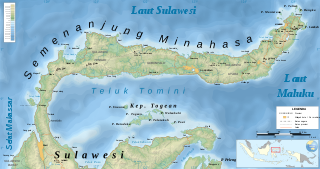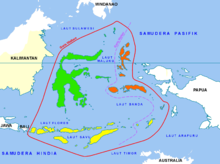
Sulawesi, also known as Celebes, is an island in Indonesia. One of the four Greater Sunda Islands, and the world's 11th-largest island, it is situated east of Borneo, west of the Maluku Islands, and south of Mindanao and the Sulu Archipelago. Within Indonesia, only Sumatra, Borneo, and Papua are larger in territory, and only Java and Sumatra have larger populations.

Bacharuddin Jusuf Habibie was an Indonesian engineer and politician who served as the third president of Indonesia from 1998 to 1999. Less than three months after his inauguration as the seventh vice president in March 1998, he succeeded President Suharto, who resigned after 32 years in office. His presidency was seen as a landmark and transition to the Reformation era.

Central Sulawesi is a province of Indonesia located at the centre of the island of Sulawesi. The administrative capital and largest city is located in Palu. The province borders the provinces of Gorontalo to the east, Southeast Sulawesi, South Sulawesi, and West Sulawesi to the south, and sharing maritime borders with East Kalimantan to the west, North Maluku to the east, and Malaysia and the Philippines to the north. The 2010 census recorded a population of 2,635,009 for the province, and the 2020 Census recorded 2,985,734, of whom 1,534,706 were male and 1,451,028 were female. The official estimate as at mid 2022 was 3,066,143. Central Sulawesi has an area of 61,605.72 km2 (23,786 sq mi), the largest area among all provinces on Sulawesi Island, and has the second-largest population on Sulawesi Island after the province of South Sulawesi. It is bordered by the provinces of Gorontalo to the north, West Sulawesi, South Sulawesi and South East Sulawesi to the south, by Maluku to the east, and by the Makassar Strait to the west. The province is inhabited by many ethnic groups, such as the Kaili, Tolitoli, etc. The official language of the province is Indonesian, which is used for official purposes and inter-ethnic communication, while there are several indigenous language spoken by the Indigenous peoples of Central Sulawesi. Islam is the dominant religion in the province, followed by Christianity which is mostly adhered to by the people in the eastern part of the province.

Poso is the administrative capital of Poso Regency, Indonesia. It is the main port and transportation hub for the central-southern coast of Central Sulawesi. Its urban area consists of three districts, Poso Kota, North Poso Kota, and South Poso Kota. Poso lies in the middle of the province on the shore of the Gulf of Tomini, right in the central part of Sulawesi island. With a total population of 47,477 in 2020, it is one of the biggest and the oldest towns in the province.

Palu, officially known as the City of Palu, is the capital and largest city of Central Sulawesi. Palu is located on the northwestern coast of Sulawesi and borders Donggala Regency to the north and west, Parigi Moutong Regency to the east, and Sigi Regency to the south. The city boundaries encompass a land area of 395.06 km2 (152.53 sq mi). According to the 2020 Indonesian census, Palu had a population of 373,218, making it the third-most populous city on the island after Makassar and Manado; the official estimate as at mid 2022 was 381,572 - comprising 191,052 males and 190,520 females. Palu is the center of finance, government, and education in Central Sulawesi, as well as one of several major cities on the island. The city hosts the province's main port, its biggest airport, and most of its public universities.

The Togian Islands are an archipelago of 56 islands and many offshore islets, situated in the Gulf of Tomini, off the coast of Central Sulawesi, in Indonesia. The largest islands are Batudaka, Togean, Talatako and Una-Una. There are 59 villages on the islands, with one settled by the Bajau people, more commonly known as the sea gypsies.

The Minahasa Peninsula, also spelled Minahassa, is one of the four principal peninsulas on the Indonesian island of Sulawesi. It stretches north from the central part of the island, before turning to the east and forming the northern boundary of the Gulf of Tomini and the southern boundary of the Celebes Sea.

Gorontalo is a city and the capital of the Gorontalo Province, Indonesia. It is on the island of Sulawesi. The city has an area of 79.59 km2 and had a population of 179,991 at the 2010 census and 198,539 at the 2020 census; the official estimate as at mid 2022 was 201,350 (comprising 100,043 males and 101,307 females.
This is a list of some of the regions of Indonesia. Many regions are defined in law or regulations by the central government. At different times of Indonesia's history, the nation has been designated as having regions that do not necessarily correlate to the current administrative or physical geography of the territory of the nation.

The following outline is provided as an overview of and topical guide to Indonesia:

North Penajam Paser Regency is a regency in the Indonesian province of East Kalimantan. Its administrative centre is the town of Penajam. The area which now forms North Penajam Paser was part of Paser Regency until its creation as a separate regency on 10 April 2002. It covers an area of 3,333.06 km2 and it had 142,922 inhabitants at the 2010 census and 178,681 at the 2020 census; the official estimate as at mid 2022 was 183,043. North Penajam Paser Regency has the smallest area among the seven regencies in East Kalimantan province.

The capital of Indonesia is Jakarta, one of the oldest continuously inhabited cities in Southeast Asia. Previously known as Batavia, it was the de facto capital of the Dutch East Indies. In the early 20th century, the Dutch East Indies government attempted to relocate the capital from Batavia to Bandung. During Indonesia's struggle for independence, the Indonesian government moved the capital to Yogyakarta and then to Bukittinggi, where it remained for a short time until the restoration of control to Jakarta. In 2019, during his annual state of the union address at the parliament, President Joko Widodo announced a plan to relocate the capital to Kalimantan on the island of Borneo. As part of the plan, part of Kutai Kartanegara Regency and Penajam North Paser Regency in East Kalimantan will be carved out to create a new province-level planned city, and the capital will be relocated to a more central location within Indonesia. On 17 January 2022, the name was revealed to be Nusantara.

Gorontalo is a province of Indonesia on the island of Sulawesi. Located on the Minahasa Peninsula, Gorontalo was formerly part of the province of North Sulawesi until its inauguration as a separate province on 5 December 2000. The province is bordered by the provinces of North Sulawesi to the east and Central Sulawesi to the west, as well sharing a maritime border with the Philippines to the north. The provincial capital, as well as the main gateway to the province and its most populated city, is Gorontalo .The size is comparable to Vanuatu.

Islam in Central Sulawesi, a province of Indonesia, is the majority religion embraced by around 75% of the province's 2,683,722 inhabitants . The propagators of Islam were thought to enter Central Sulawesi through neighboring regions, namely Bone, Wajo, and Mandar from the south and west routes, and through Gorontalo and Ternate from the north and east routes via Tomini Bay and Tolo Bay.

On 28 September 2018, a shallow, large earthquake struck in the neck of the Minahasa Peninsula, Indonesia, with its epicentre located in the mountainous Donggala Regency, Central Sulawesi. The magnitude 7.5 quake was located 70 km (43 mi) away from the provincial capital Palu and was felt as far away as Samarinda on East Kalimantan and also in Tawau, Malaysia. This event was preceded by a sequence of foreshocks, the largest of which was a magnitude 6.1 tremor that occurred earlier that day.

Rusdy Mastura is an Indonesian politician who is the governor of Central Sulawesi and was the mayor of the province's capital, Palu, between 2005 and 2015.

Nusantara, officially the Capital City of Nusantara, is the future capital of Indonesia, scheduled to be inaugurated on 17 August 2024, coinciding with Indonesian Independence Day. Nusantara will replace Jakarta as the national capital, a position the latter city has held since the country's proclamation of independence in 1945.
The Law on South Kalimantan province, officially Law Number 8 of 2022, is a law passed by the People's Representative Council of Indonesia regarding the existence of the province of South Kalimantan. The law is one of several laws passed with relatively minor changes to provide an updated legal basis for the existence of Indonesian provinces; previously, the legal standing for many Indonesian provinces was based on laws from the era of the United States of Indonesia. However, while other provinces' laws were passed uncontroversially without major change, South Kalimantan's province law was passed with a sudden change of the capital city from Banjarmasin to Banjarbaru. This change led to a court challenge from elements associated with Banjarmasin city, with consequent response from Banjarbaru city.
















